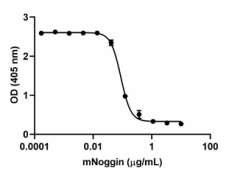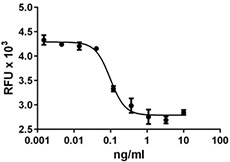- Regulatory Status
- RUO
- Other Names
- Nog, SYNS1A, SYNS1, SYM1
- Ave. Rating
- Submit a Review
- Product Citations
- publications

-

Recombinant mouse Noggin inhibits alkaline phosphatase production induced by recombinant human BMP-4 in the chondrogenic cell line ATDC5. The ED50 for this effect is 0.04 – 0.20 µg/mL. -

Stability Testing for Recombinant Mouse Noggin. Recombinant mouse Noggin was aliquoted in 10 mM Citric Acid, pH 3.0. One aliquot was frozen and thawed four times (4x Freeze/Thaw) and compared to the control that was kept at 4°C (Control). The samples were tested for their ability to inhibit alkaline phosphatase production induced by recombinant human BMP-4 in the chondrogenic cell line ATDC5. The ED50 for this effect is 0.04 – 0.20 µg/mL.
| Cat # | Size | Price | Quantity Check Availability | Save | ||
|---|---|---|---|---|---|---|
| 787704 | 25 µg | 265 CHF | ||||
| 787706 | 100 µg | 850 CHF | ||||
Noggin is an embryonic inducer that can sequester TGF-β cytokines of the BMP family with extremely high affinity. This protein was originally identified as a BMP-4 antagonist whose action is critical for proper formation of the head and other dorsal structures. Noggin has also been shown to modulate the activities of other BMPs including BMP-2, -7, -13, and -14. It is expressed in defined areas of the adult central nervous system and peripheral tissues such as lung, skeletal muscle, and skin. During culture of human embryonic stem cells (hESC) or neural stem cells under certain conditions, addition of Noggin to antagonize BMP activity may allow stem cells to proliferate while maintaining their undifferentiated state, or alternatively, to differentiate into dopaminergic neurons. Noggin also appears to maintain adult stem cell populations in vivo. For example, it maintains neural stem cells within the hippocampus. Targeted deletion of Noggin in mice results in prenatal death and a recessive phenotype displaying a severely malformed skeletal system. Conversely, transgenic mice over-expressing Noggin in mature osteoblasts display impaired osteoblastic differentiation, reduced bone formation, and severe osteoporosis.
Product DetailsProduct Details
- Source
- Mouse Noggin, amino acid Met- (Gln28-Cys232) (Accession: # P97466), was expressed in E.coli.
- Molecular Mass
- The 206 amino acid recombinant protein has a predicted molecular mass of approximately 23.2 kD. The DTT-reduced and non-reduced protein migrates at approximately 28 and 70 kD by SDS-PAGE, respectively. The predicted N-terminal amino acid is Gln.
- Purity
- > 95%, as determined by Coomassie stained SDS-PAGE
- Formulation
- 0.22 µm filtered protein solution is 10 mM citric acid pH 3.0.
- Endotoxin Level
- Less than 0.1 EU per µg cytokine as determined by the LAL method
- Concentration
- 25 µg size is bottled at 200 µg/mL. 100 µg size and larger sizes are lot-specific and bottled at the concentration indicated on the vial. To obtain lot-specific concentration and expiration, please enter the lot number in our Certificate of Analysis online tool.
- Storage & Handling
- Unopened vial can be stored between 2°C and 8°C for up to 2 weeks at -20°C for up to six months, or at -70°C or colder until the expiration date. For maximum results, quick spin vial prior to opening. The protein can be aliquoted and stored at -20°C or colder. Stock solutions can also be prepared at 50 - 100 µg/mL in appropriate sterile buffer, carrier protein such as 0.2 - 1% BSA or HSA can be added when preparing the stock solution. Aliquots can be stored between 2°C and 8°C for up to one week and stored at -20°C or colder for up to 3 months. Avoid repeated freeze/thaw cycles.
- Activity
- Recombinant mouse Noggin inhibits alkaline phosphatase production induced by recombinant human BMP-4 in the chondrogenic cell line ATDC5. The ED50 for this effect is 0.04 – 0.20 µg/mL.
- Application
-
Bioassay
- Application Notes
-
BioLegend carrier-free recombinant proteins provided in liquid format are shipped on blue ice. Our comparison testing data indicates that when handled and stored as recommended, the liquid format has equal or better stability and shelf-life compared to commercially available lyophilized proteins after reconstitution. Our liquid proteins are validated in-house to maintain activity after shipping on blue ice and are backed by our 100% satisfaction guarantee. If you have any concerns, contact us at tech@biolegend.com.
Antigen Details
- Structure
- Dimer
- Distribution
-
Preadiposites, skeletal muscle, lung, neuron, skin, adipose tissue.
- Function
- Regulates mainly the function of BMP-2, BMP-4, and BMP-7. Controls the development of bone, muscle, and nerve tissue among others. Modulate adipose tissue and obesity in vivo, required for early development of murine upper incisors.
- Interaction
- Mesenchymal stem cells, embryonic stem cells
- Ligand/Receptor
- BMP-2, BMP-4, BMP-5, BMP-6, BMP-7, BMP-13, and BMP-14
- Bioactivity
- Recombinant mouse Noggin inhibits alkaline phosphatase production induced by human BMP4 in the chondrogenic cell line ATDC5.
- Cell Type
- Embryonic Stem Cells, Mesenchymal Stem Cells
- Biology Area
- Cell Biology, Immunology, Neuroscience, Signal Transduction, Stem Cells, Synaptic Biology
- Molecular Family
- Cytokines/Chemokines, Growth Factors
- Antigen References
-
Valenzuela DM, et al. 1995. J. Neurosci. 15:6077.
McMahon JA, et al. 1998. Genes Dev. 12:1438.
Yuasa S, et al. 2005. Nat. Biotechnol. 23:607.
Gong Y, et al. 1999. Nat. Genet. 21:302.
Chiba S, et al. 2008. Stem Cells 26:2810.
Bonaguidi MA, et al. 2008. J. Neurosci. 28:9194.
Hu X, et al., 2012. J. Dent. Res. 91:394.
Blázquez-Medela AM, et al., 2019. Mol. Met. 25: 50.
Blázquez-Medela AM, et al., 2019. Obes Rev. 20:648. - Gene ID
- 18121 View all products for this Gene ID
- UniProt
- View information about Noggin on UniProt.org
Related FAQs
- Why choose BioLegend recombinant proteins?
-
• Each lot of product is quality-tested for bioactivity as indicated on the data sheet.
• Greater than 95% Purity or higher, tested on every lot of product.
• 100% Satisfaction Guarantee for quality performance, stability, and consistency.
• Ready-to-use liquid format saves time and reduces challenges associated with reconstitution.
• Bulk and customization available. Contact us.
• Learn more about our Recombinant Proteins. - How does the activity of your recombinant proteins compare to competitors?
-
We quality control each and every lot of recombinant protein. Not only do we check its bioactivity, but we also compare it against other commercially available recombinant proteins. We make sure each recombinant protein’s activity is at least as good as or better than the competition’s. In order to provide you with the best possible product, we ensure that our testing process is rigorous and thorough. If you’re curious and eager to make the switch to BioLegend recombinants, contact your sales representative today!
- What is the specific activity or ED50 of my recombinant protein?
-
The specific activity range of the protein is indicated on the product datasheets. Because the exact activity values on a per unit basis can largely fluctuate depending on a number of factors, including the nature of the assay, cell density, age of cells/passage number, culture media used, and end user technique, the specific activity is best defined as a range and we guarantee the specific activity of all our lots will be within the range indicated on the datasheet. Please note this only applies to recombinants labeled for use in bioassays. ELISA standard recombinant proteins are not recommended for bioassay usage as they are not tested for these applications.
- Have your recombinants been tested for stability?
-
Our testing shows that the recombinant proteins are able to withstand room temperature for a week without losing activity. In addition the recombinant proteins were also found to withstand four cycles of freeze and thaw without losing activity.
- Does specific activity of a recombinant protein vary between lots?
-
Specific activity will vary for each lot and for the type of experiment that is done to validate it, but all passed lots will have activity within the established ED50 range for the product and we guarantee that our products will have lot-to-lot consistency. Please conduct an experiment-specific validation to find the optimal ED50 for your system.
- How do you convert activity as an ED50 in ng/ml to a specific activity in Units/mg?
-
Use formula Specific activity (Units/mg) = 10^6/ ED50 (ng/mL)

 Login / Register
Login / Register 











Follow Us